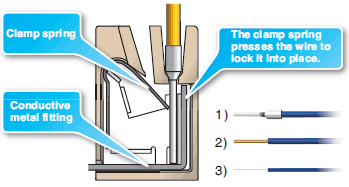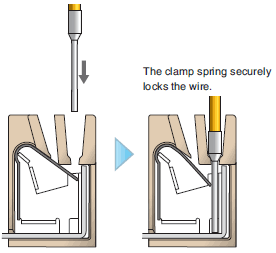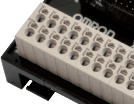Wiring Systems
| Introduction | Features |
| Principles | Classifications |
| Engineering Data |
|
|
|
Troubleshooting |
-
 What Is a Wiring System?
What Is a Wiring System?
-
 Classifications
Classifications
-
 Product Lineup and Features
Product Lineup and Features
-
 What Is a Push-In Plus Terminal Block?
What Is a Push-In Plus Terminal Block?
-
 Terminal Block Types and Connection Methods
Terminal Block Types and Connection Methods
-
 Mechanism of Screwless Terminal Blocks
Mechanism of Screwless Terminal Blocks
-
 Differences between Push-In Terminal Blocks and Push-In Plus Terminal Blocks
Differences between Push-In Terminal Blocks and Push-In Plus Terminal Blocks
-
 Products That Support Push-In Plus Terminal Blocks
Products That Support Push-In Plus Terminal Blocks
What Is a Wiring System?
A Wiring System is a device that is used to convert a connection to a connector to connect (wire) a device or circuit.
Converting connections to connectors makes it possible to connect and disconnect devices with just your hands or simple tools.
This document classifies Wiring Systems used mainly in industrial equipment as follows.
Industrial Ethernet Cables
Industrial Ethernet Cables and Connectors support Industrial Ethernet (open networks) including EtherNet/IPTM and EtherCAT®. In factories, certainty of information transmission (transmission in real time) and noise tolerance are required. Therefore, unlike the LAN used in general offices and homes, connectors that are robust and water-resistant are used in factories. Also, the use of cables with a shielded structure ensures a high connection quality.
Sensor I/O Connectors
Sensor I/O Connectors are used to convert the wiring for input devices including sensors and actuators into a connector. At workplaces that require a high connection reliability, round water-resistant connectors having excellent resistance to environment such as water and oil resistance are used.
Connector-Terminal Block Conversion Unites
A Connector-Terminal Block Conversion Unit is a terminal block conversion unit with a prewired connector that can be used to wire all the I/O for a programmable controller (hereinafter, PLC) with a single cable.
Classifications



Product Lineup and Features
Industrial Ethernet Cables
Industrial Ethernet Cables and Connectors support Industrial Ethernet (open networks) including EtherNet/IPTM and EtherCAT®.
In factories, certainty of information transmission (transmission in real time) and noise tolerance are required. Therefore, unlike the LAN used in general offices and homes, connectors that are robust and water-resistant are used in factories. Also, the use of cables with a shielded structure ensures a high connection quality.
OMRON provides cables with RJ45 connectors for use in-panel, and cables with M12 connectors (round water-resistant connectors) for use outside the control panel where resistance to the environment is required.
Features of Cables with RJ45 Connectors

*1. For details on transmission characteristics, see Ethernet Communication Speed and Standards.
*2. In spite of being a single-shielded structure, it satisfies the standard values of the communication and noise characteristics.
*3. LSZH is the abbreviation for Low Smoke Zero Halogen. Fire-retardant, and does not generate poisonous gases even when burned.
Assembly Connectors
Enables easy on-site Ethernet cable assembly without crimp tools or other special tools.

Features of Cables with M12 Connectors

Note: All M12 Industrial Ethernet Connectors are D-coded. For details on coding, see Information on Standards on Explanation of Terms.
Cables with RJ45/M12 Connectors are also available. For details, see Industrial Ethernet Cables Catalog (Cat. NO. G019-E1).
Ethernet Communication Speed and Standards
Be sure to use Ethernet Cables and Connectors that supports Ethernet speed (Band rate) you need. As the communication speed becomes faster, the frequency increases, and the signal tends to get distorted, because of which the required specifications become restrictive. For that reason check the Ethernet speed (Band rate) of your PLC, sensors, and any other component you plan to use and select cables and connectors that complies with the necessary standards.

Note: For 100BASE-TX/10BASE-T, use a straight or cross STP (shielded twisted-pair) cable of category 5 or higher.
For 1000BASE-T, use a straight or cross STP cable of category 5e or higher with double shielding (aluminum tape and braiding).
For details on STP and straight/cross cables, see Explanation of Terms.
Smartclick
OMRON’s M12 Connectors (Industrial Ethernet Cables XS5[]-T Series and Sensor I/O Connectors XS5 Series) are Smartclick Connectors that enable completion of the connection by turning the connector approximately 1/8 of a turn.

Sensor I/O Connectors
Sensor I/O Connectors are used to convert the wiring for input devices including sensors and actuators into a connector. At workplaces that require a high connection reliability, round water-resistant connectors (M12/M8 Connectors) having excellent resistance to environment such as water and oil resistance are used.
OMRON offers various models to suit different uses.

Features of Pressure-welded Assembly Connectors Clarifies Assembly Completion Position
Assembly is completed with any type of cable simply by pressing the cable all the way in. The tightened position is clear, so you can visually confirm assembly completion.

Wide Range of Cables
Two sizes of bushings (one for large-diameter cables and one for small-diameter cables) are provided to support cable diameters from 3 mm to 8 mm.

Note: Use an A-coded connector for DC Sensors and a B-coded connector for AC Sensors. For details on coding, see Information on Standards on Explanation of Terms.
Connector-Terminal Block Conversion Unites
A Connector-Terminal Block Conversion Unit is a terminal block conversion unit with a prewired connector that can be used to wire all the I/O for a programmable controller (PLC) with a single cable.
OMRON provides Units for PLCs, which have wiring patterns specialized for PLC connections, and Units for general-purpose devices.
Recently, the use of devices with push-in terminal blocks has been increasing in order to improve work efficiency. In particular, push-in terminal blocks on Connector-Terminal Block Conversion Units that are used to connect to PLCs with their many signals make it possible to reduce space requirements and reduce wiring work.
OMRON’s lineup also includes conventional Units with phillips screws or slotted screws, Units with e-CON specification, and more.

Features of Units with Push-in Terminal Blocks
Structure

With a push-in terminal block, a wire is inserted and the clamp spring presses against the wire to lock it into place.
Three types of wire can be used: 1) wires with ferrules, 2) solid wires, and 3) stranded wires.

Connecting a Wire
If you use a wire with a ferrule, you can wire by inserting the ferrule into the push-in terminal block. Also, there is no need for retightening screws after shipping, so installation can be performed immediately.

Pullout Strength
The pullout strengths of push-in terminal blocks are specified in the JIS C 8201-7-1 or IEC 60947-7-1 standard.
Example: Pullout Strengths for Wires with Ferrules

What Is a Push-In Plus Terminal Block?
A push-in terminal block allows you to connect wires by just pushing them in. Reducing wiring work when building control panels can greatly reduce production work.
Push-In Plus Terminal Blocks were independently developed by OMRON for easier wire insertion and firmer wire holding ability than standard push-in terminal blocks.
Terminal Block Types and Connection Methods
General terminal block types and how to connect them are shown in the following table.
| Terminal block type | Screw terminal blocks | Screwless terminal blocks | ||
| This type of terminal block is structured to connect and fasten wires or crimp terminals directly or with a washer at the bottom of the heads of the terminal screws. | This type of terminal block is structured to connect with the pressure of the spring directly or with a metal strip when you insert the wire between the conductive fitting and the spring. | |||
| For forked or round terminals | For pin terminals | Clamp type | Push-in type | |
| Securing method | Screws | Springs | ||
| Terminal blocks |  |  |  |  |
| Applicable crimp terminals *1 |  |  |  | |
| Connection steps | Three-step connection (1) Loosen the screw with the tool. (2) Insert the terminal. (3) Tighten the screw with the tool. | Three-step connection (1) Insert the tool. (2) Insert the ferrule. (3) Remove the tool. | One-step connection *3 (1) Insert the ferrule. | |
| Connection tool | Required | Required | Not required | |
*1. Bare wires (solid or stranded) can also be used.
*2. For details on ferrules, refer to * What is a Ferrule?.
*3. A solid bare wire can be connected in one step, but a stranded bare wire requires three steps.
Mechanism of Screwless Terminal Blocks
This section describes the mechanisms and connection methods for push-in and clamp type terminal blocks.
Push-in Type (Example for XW2R-P)
How to insert wire
Using Wires with Ferrules or Solid Wires
The wire should be pushed into the terminal block till stopping.
The clamp spring opens automatically when the conductor is pushed in.
This applies the necessary force to the conductive fitting and the wire is held securely.

Wiring Completed in One Step

Using Stranded Wires

Wiring Completed in Three Steps
(1) Press the flat-blade screwdriver diagonally into the release hole.

(2) Leave the flat-blade screwdriver pressed into the release hole and insert the wire into the terminal hole.
Insert the wire until the stripped portion is no longer visible to prevent shorting.

(3) Remove the flat-blade screwdriver from the release hole.
After you connect the wires, pull gently on the wire to make sure that it will not come off and the wire is securely fastened to the terminal block.

How to release wire (Same for Wires with Ferrules, Solid Wires, or Stranded Wires)

(1) Press the flat-blade screwdriver diagonally into the release hole.

(2) Leave the flat-blade screwdriver pressed into the release hole and pull out the wire.

(3) Remove the flat-blade screwdriver from the release hole.

Clamp Type (Example for PYF[][]S)

Wiring Completed in Three Steps

(1) Insert the screwdriver into the screwdriver insertion hole. (The spring at the back of the wire insertion hole will be open.)
(2) Insert the wire or terminal into the wire insertion hole.
(3) Remove the screwdriver. The spring will hold the wire.
* What is a Ferrule?
Ferrules are a European type of pin terminal to prevent unraveling of stranded wire and to stabilize the quality of electrical connections. They are smaller than standard pin crimp terminals and were designed to reduce the size of terminal blocks.

<Reference Information>
The processing flow for wires with ferrules is as follows:

Note:
1. Attaching the ferrule to the wire requires a crimping tool.
2. For information on recommended ferrules and crimping tools, refer to the datasheet of individual products.
Differences between Push-In Terminal Blocks and Push-In Plus Terminal Blocks
Push-In Plus Terminal Blocks use technology for easier wire insertion with firmer wire holding ability than previous push-in terminal blocks. They help reduce the time and work involved in wiring.
Easy to Insert
OMRON's Push-In Plus terminal blocks are as easy as inserting to an earphone jack. They help reduce the work load and improve wiring quality.

Work with Both Hands
Optimized shape to hold the screwdriver was created by the resin parts and the spring.
Work goes smoothly when connecting stranded wires directly to the terminal because it’s easier to aim at the desired terminal.

Held Firmly in Place
Even though less insertion force is required, the wires are held firmly in place. The advanced mechanism design technology and manufacturing technology produced a spring that ensures better workability and reliability.

* Information for Push-In Plus terminal blocks and Screw terminal blocks is based on OMRON's actual measurement value data for the XW2R.
Products That Support Push-In Plus Terminal Blocks
(As of October 2019)
• Switch Mode Power Supplies
• Noise Filter
• DC Electronic Circuit Protector
• Low Voltage Switching Gears
• Sockets
For Relays (MY, LY, G2R-S)
For Relays with Forcibly Guided Contacts (G7SA)
For Timers (H3Y-[]-B and H3YN-B)
For Liquid Leakage Sensor Amplifiers (K7L-[][]B)
• Slim I/O Relays
• Terminal Relay
• I/O Relay Terminal
• Solid State Relays for Heaters
• Solid State Timer
• Measuring and Monitoring Relays
• DIN Track Push-in Terminal Blocks
• Common Terminal Blocks with Visible Indicators
• Power Monitors
• Uninterruptible Power Supply (UPS)
• Pushbutton Switches
• Emergency Stop Pushbutton Switches
• Digital Temperature Controller
• Machine Automation Controllers
• EtherCAT Slave Terminals NX-Series
Refer to the Panel Solution site (www.ia.omron.com/solution/panel/) for details.
EtherCAT® is registered trademark and patented technology, licensed by Beckhoff Automation GmbH, Germany.